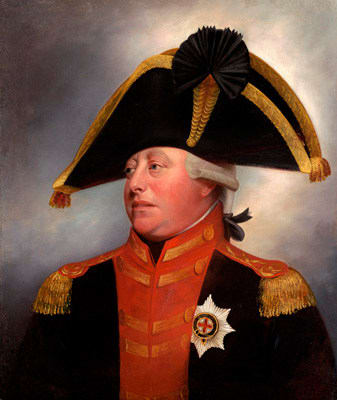
Studio of Sir William Beechey RA
Portrait of George III, c. 1800
Oil on canvas
30 x 25 in.
Philip Mould & Co.
To view all current artworks for sale visit philipmould.com This striking portrait of George III was painted in the studio of one of the monarch’s favourite artists, Sir William Beechey....
To view all current artworks for sale visit philipmould.com
This striking portrait of George III was painted in the studio of one of the monarch’s favourite artists, Sir William Beechey. The original work, a full-length, was exhibited at the Royal Academy in 1800 (it is now in the Royal Collection) and showed the King standing in front of a horse and a groom. It soon became an established likeness of the king, and was widely engraved and reproduced.
At the time the original was commissioned, support for George as the nation’s father-figure was at its height. He was, after all, the first Hanoverian to speak fluent English, and considered himself first and foremost a Briton. He could thus relate more easily to his subjects, who relished not being ruled by a foreigner for a change. He was affectionately nicknamed ‘Farmer George’, after his keen interest in agriculture. He became still more popular late in life (even after the loss of the America’s) following his famous ‘illness’, as it was delicately called. George first became delusional in the late 1780s, but recovered sufficiently to prevent the Whigs forming a regency under his son, the Prince of Wales. Thereafter he became increasingly viewed with pity and fondness by the public, and particularly the press. Then, in the 1790s, the radical horrors of the French Revolution further reinforced the popularity of England’s long-serving, conservative monarch.
Inevitably, George’s portraiture became increasingly sought after, and Beechey’s amiable likeness was one of the most popular. Several studio versions of the full-length were made, and can be found today in the National Portrait Gallery, Hatfield House, and the National Maritime Museum, while smaller replicas such as the present example proved highly popular. The likeness represents the last time the King was painted for a major work before his slow descent into madness.
Beechey was perfectly placed for the task of painting a flattering, monarchical image. His straightforward style perfectly suited the conventional taste of the royal family, and he had been employed by them since 1793. He had painted almost all George’s children, and exhibited six royal portraits at the Royal Academy in 1797. His 1798 George III Reviewing the Dragoons [Royal Collection] won him a knighthood, and he went on to become principal portrait painter to William IV.
This striking portrait of George III was painted in the studio of one of the monarch’s favourite artists, Sir William Beechey. The original work, a full-length, was exhibited at the Royal Academy in 1800 (it is now in the Royal Collection) and showed the King standing in front of a horse and a groom. It soon became an established likeness of the king, and was widely engraved and reproduced.
At the time the original was commissioned, support for George as the nation’s father-figure was at its height. He was, after all, the first Hanoverian to speak fluent English, and considered himself first and foremost a Briton. He could thus relate more easily to his subjects, who relished not being ruled by a foreigner for a change. He was affectionately nicknamed ‘Farmer George’, after his keen interest in agriculture. He became still more popular late in life (even after the loss of the America’s) following his famous ‘illness’, as it was delicately called. George first became delusional in the late 1780s, but recovered sufficiently to prevent the Whigs forming a regency under his son, the Prince of Wales. Thereafter he became increasingly viewed with pity and fondness by the public, and particularly the press. Then, in the 1790s, the radical horrors of the French Revolution further reinforced the popularity of England’s long-serving, conservative monarch.
Inevitably, George’s portraiture became increasingly sought after, and Beechey’s amiable likeness was one of the most popular. Several studio versions of the full-length were made, and can be found today in the National Portrait Gallery, Hatfield House, and the National Maritime Museum, while smaller replicas such as the present example proved highly popular. The likeness represents the last time the King was painted for a major work before his slow descent into madness.
Beechey was perfectly placed for the task of painting a flattering, monarchical image. His straightforward style perfectly suited the conventional taste of the royal family, and he had been employed by them since 1793. He had painted almost all George’s children, and exhibited six royal portraits at the Royal Academy in 1797. His 1798 George III Reviewing the Dragoons [Royal Collection] won him a knighthood, and he went on to become principal portrait painter to William IV.
Provenance
Exhibitions
Literature
Be the first to hear about our available artworks
* denotes required fields
We will process the personal data you have supplied in accordance with our privacy policy (available on request). You can unsubscribe or change your preferences at any time by clicking the link in our emails.